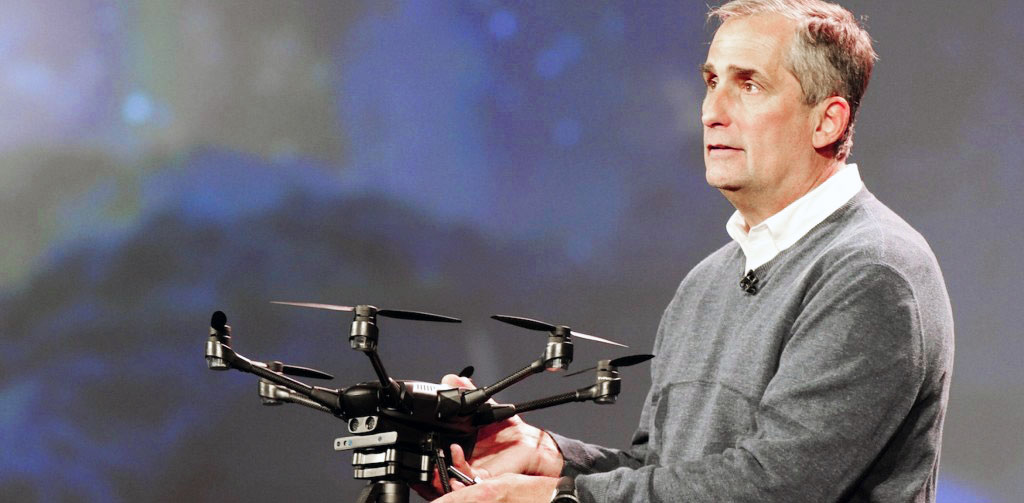
Robohub.org
The Drone Center’s Weekly Roundup: 1/11/16

At the 2016 Consumer Electronics Show, Intel Corporation CEO Brian Krzanich released footage of a display that set the Guinness World Record for most drones in the air at a time. Image via: Intel
At the Center for the Study of the Drone
Our Media Portals page was created in January 2015 to serve as resources for individuals interested in studying drones. As the Bard spring academic semester looms, we are updating our media libraries with online lectures, podcasts, and panel discussions. This week, we added new material to our Terrorism and Targeted Killing to reflect a few of the developments of the past year.
News
The Federal Aviation Administration announced that over 181,000 drone users registered with the government since registration was opened on December 21. The FAA also released an iPhone app that allows operators to see where they may and may not fly. (USA Today)
Meanwhile, a Maryland resident filed a lawsuit alleging that the FAA’s drone registration program is not legal. John A. Taylor, a drone hobbyist and insurance attorney, argues that the registration rule violates Section 336 of the FAA Modernization and Reform Act of 2012. According to Forbes, Mr. Taylor decided to sue the FAA after major hobbyist groups such as the Academy of Model Aeronautics chose not to pursue legal action.
After a two-year review, the Department of Defense rejected plans to create a unique medal specifically for personnel who operate drones and conduct cyber activities. Instead, the Pentagon intends to offer a pin that can be attached to existing non-combat medals. The “Distinguished Warfare Medal” was withdrawn shortly after it was introduced in 2013 following criticism from veterans groups. (Military Times)
An American MQ-1 Predator drone crashed in Iraq after the operators lost control of the aircraft. In a statement, the U.S. Air Force said the drone was completely destroyed and had not fallen into the hands of ISIS militants. It is the first major U.S. drone crash so far this year. (Air Force Times)
Commentary, Analysis, and Art
At Morning Consult, Amir Nasr reports that in spite of warnings from the FAA, state governments are expected to continue pursuing local drone regulations in 2016.
Meanwhile, at Lawfare, Ashley Deeks takes a look at the role of states in regulating airspace.
At Politico, Tony Romm writes that a push by the Obama administration to create privacy protections surrounding the use of drones is unlikely to gain much ground in 2016.
At the Washington Post, Matthew Levitt argues that the American counterterrorism strategy is beginning to rely more on international partnerships than on drones.
Also at the Washington Post, Todd C. Frankel writes that humans—not technology—could prevent delivery drone concepts from being realized.
At the 2016 Consumer Electronics Show, Intel Corporation released footage of a display that set the Guinness World Record for most drones in the air at a time.
At Drone360, Tim Kidwell takes a look at the discussion over policy and regulation at the Consumer Electronics Show.
At TechCrunch, Romain Dillet speaks with Parrot CEO Henri Seydoux about the future of drones and Parrot’s new fixed-wing aircraft.
Meanwhile, Engadget spoke with 3D Robotics CEO Chris Anderson about how drones need to be “smart and simple.”
At Forbes, Ryan Mac argues that the drone industry suffers from wildly inflated expectations and reality distortion.
Also at Forbes, Aaron Tilley reports that startup drone manufacturer Lily Robotics received $34 million in preorders for its self-flying drone.
At the Verge, Ben Popper discusses the drone safety with Brendan Schulman, the chief lawyer in Washington for drone manufacturer DJI.
The Editorial Board at the New York Times argues that policymakers should aim first for protecting privacy and safety when crafting rules for drones.
Meanwhile, in a letter to the editor at the New York Times, Philip Weinberg writes that the FAA should look to the EPA for an example of how it can work with state governments to regulate drones.
At the Electronic Frontier Foundation, Shahid Buttar argues that the Department of Homeland Security’s guidance on drone privacy measures “leaves much to be desired.”
At Popular Science, Kelsey D. Atherton takes a look at how Russia’s new drone regulations mirror those in the United States.
At Air & Space Magazine, Donald W. Skrull discusses how his career in aerospace engineering began as a model aircraft hobby.
At the Huffington Post, Charlotte Alfred writes that the closure of the drone base in Arba Minch, Ethiopia doesn’t necessarily signal the end to operations in Africa.
At Slate, Justin Peters argues that the FAA’s B4UFLY app can’t serve in the place of a “comprehensive suite of actual, enforceable rules and regulations.”
At the Bureau of Investigative Journalism, Jack Serle writes that drone strikes in Pakistan fell to the “lowest level in eight years,” while the number of strikes in Somalia rose in 2015.
At Global News, Leslie Young writes that Canada’s transportation ministry is expected to release a new set of drone regulations by 2017.
Know Your Drone
Wired takes a close look at the varied drones that were on display at the Consumer Electronics Show.
A pair of researchers at the Stanford Intelligent Systems Laboratory is simulating autonomous airspace deconfliction systems for NASA’s drone air traffic management project. (MIT Technology Review)
At the Consumer Electronics Show, European aerospace and defense company Airbus showed off its drone tracking and jamming system, which can detect and disrupt small unmanned aircraft flights up to 6.2 miles away. (Fortune)
Meanwhile, at CES, Google and Amazon described their differing proposals for air traffic management systems for drones. (TechCrunch)
Flypro, a consumer drone company, has unveiled a multirotor drone that can be controlled with voice commands. (Flypro Press Release)
A consortium of Brazilian and Israeli companies has halted plans to develop a surveillance and reconnaissance drone for the Brazilian armed forces. (Flightglobal)
A team at the U.S. Naval Research Laboratory is developing and testing algorithms that enable cooperative flight operations among multiple unmanned sailplanes, which allows the aircraft to stay airborne for longer stretches of time. (UPI)
A researcher at Delft University of Technology is developing a drone navigation and obstacle avoidance system that uses a single camera. (TU Delft)
Meanwhile, a company called Stereolab has unveiled a stereo depth sensor that can be attached to drones for obstacle avoidance. (TechCrunch)
Israeli company Tactical Robotics has conducted the first untethered flight test of its AirMule vertical take-off and landing military drone. (UPI)
A team at Michigan Technological University has developed a drone that can ensnare other drones with a net from up to 12 feet away. (CNET)
Drones at Work
IAG, an Australian insurance agency, used a drone to inspect damage caused by a brushfire in Victoria, a first for Australia. (Mashable)
ESPN joined the International Ski Federation in banning drones from competitions after a drone nearly hit a skier at an event in December. (Powder)
The World Bank supported a project in the Balkans that used drones to map disputed lands.
A team from ABC News’ Good Morning America flew a drone into a sinkhole in Iceland.
Police in the U.K. are exploring whether drones are more cost-effective in a variety of situations than existing aerial or ground-based tools. (Mashable)
For updates, news, and commentary, follow us on Twitter. The Weekly Drone Roundup is a newsletter from the Center for the Study of the Drone. It covers news, commentary, analysis and technology from the drone world. You can subscribe to the Roundup here.
tags: c-Aerial, drones, UAVs




